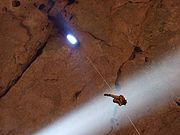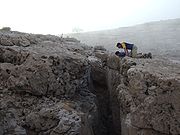
Majlis al Jinn
Encyclopedia





Jinn
Jinn are supernatural beings in Arab folklore and Islamic teachings.Jinn may also refer to:* Jinn , a Japanese band* Qui-Gon Jinn, a character in the Star Wars universe...
), local name: Khoshilat Maqandeli is the ninth largest cave
Cave
A cave or cavern is a natural underground space large enough for a human to enter. The term applies to natural cavities some part of which is in total darkness. The word cave also includes smaller spaces like rock shelters, sea caves, and grottos.Speleology is the science of exploration and study...
chamber in the world, as measured by the surface area of the floor. It ranks higher when measured by volume. The cave is located in a remote area of the Selma Plateau at 1,380 metres above sea level in the Sultanate of Oman
Oman
Oman , officially called the Sultanate of Oman , is an Arab state in southwest Asia on the southeast coast of the Arabian Peninsula. It is bordered by the United Arab Emirates to the northwest, Saudi Arabia to the west, and Yemen to the southwest. The coast is formed by the Arabian Sea on the...
, 100 km south-east from Muscat
Muscat, Oman
Muscat is the capital of Oman. It is also the seat of government and largest city in the Governorate of Muscat. As of 2008, the population of the Muscat metropolitan area was 1,090,797. The metropolitan area spans approximately and includes six provinces called wilayats...
.
Description
The Selma Plateau is a shallow synclineSyncline
In structural geology, a syncline is a fold, with younger layers closer to the center of the structure. A synclinorium is a large syncline with superimposed smaller folds. Synclines are typically a downward fold, termed a synformal syncline In structural geology, a syncline is a fold, with younger...
on the north-eastern limb of the Jabal Bani Jabir anticline
Anticline
In structural geology, an anticline is a fold that is convex up and has its oldest beds at its core. The term is not to be confused with antiform, which is a purely descriptive term for any fold that is convex up. Therefore if age relationships In structural geology, an anticline is a fold that is...
. The cave was formed in fossiliferous carbonate rocks of the Middle Eocene
Eocene
The Eocene Epoch, lasting from about 56 to 34 million years ago , is a major division of the geologic timescale and the second epoch of the Paleogene Period in the Cenozoic Era. The Eocene spans the time from the end of the Palaeocene Epoch to the beginning of the Oligocene Epoch. The start of the...
Hadhramaut
Hadhramaut
Hadhramaut, Hadhramout, Hadramawt or Ḥaḍramūt is the formerly independent Qu'aiti state and sultanate encompassing a historical region of the south Arabian Peninsula along the Gulf of Aden in the Arabian Sea, extending eastwards from Yemen to the borders of the Dhofar region of Oman...
Group, Dammam Formation. It is one of several caves on the Selma Plateau.
Majlis al Jinn is a single chamber measuring about 310 metres by 225 metres, with a domed ceiling 120 metres high and three entrances in the roof. The totally free-standing roof is only about 40 metres thick over most of the cave. The deepest part of the cave is 178 metres below the top of the highest entrance. The volume of the chamber is approximately 4,000,000 cubic metres, and the floor area is 58,000 square metres.
When it was surveyed in 1985, Majlis al Jinn was the second largest known cave chamber in the world by volume. However, more than 15 chambers larger than Majlis al Jinn have been surveyed since that time.
There are no visible lower exits or passages leading from the chamber–these passages most likely have been blocked by debris on cave floor. Water entering the cave collects along the lowest part of the floor, then slowly infiltrates into the fine-grained, mud-cracked sediment
Sediment
Sediment is naturally occurring material that is broken down by processes of weathering and erosion, and is subsequently transported by the action of fluids such as wind, water, or ice, and/or by the force of gravity acting on the particle itself....
or evaporates. The entrances receive surface runoff from only a small drainage area, so water never reaches most parts of the cave. While surface temperatures can exceed 40oC, air temperatures in the chamber are a constant 17-18oC.
Access to the cavern is only through a free descent of one of three vertical entrances in the ceiling, formed by water seeping through the weakened marly limestone in the zones of fracturing. The two largest entrances are called Asterisk (Khoshilat Beya Al Hiyool) and First Drop (Khoshilat Maqandeli), the smallest is Cheryl's Drop (Khoshilat Minqod) . Entrance depths:Cheryl's Drop - 158.2 meters. Asterisk - 139.6 meters. First Drop - 118.0 meters.
Below the two larger entrances are high piles of rocks ("breakdown.") The remains of goats, birds, and snakes have been found on the floor of the chamber. The entrance openings in the ceiling provide ambient light in the chamber most of the day. There are only a few stalactite
Stalactite
A stalactite , "to drip", and meaning "that which drips") is a type of speleothem that hangs from the ceiling of limestone caves. It is a type of dripstone...
s and draperies on the ceiling and walls, but moderate and fragile speleothem
Speleothem
A speleothem , commonly known as a cave formation, is a secondary mineral deposit formed in a cave. Speleothems are typically formed in limestone or dolostone solutional caves.-Origin and composition:...
s are common on the floor. Growth only occurs during times of seepage and drips following heavy rains.
Access
Until fairly recently there had not been a way to reach the cave by car, so cavers had to hike in carrying their equipment or rent donkeys from a village a few hours walk from the cave entrance. The original explorers, Don and Cheryl, often flew into the area by helicopter. Now the cave can be reached on a rough track, which requires four-wheel driveFour-wheel drive
Four-wheel drive, 4WD, or 4×4 is a four-wheeled vehicle with a drivetrain that allows all four wheels to receive torque from the engine simultaneously...
.
Cavers entering Majlis al Jinn require about 200m of specialized rope and equipment to descend and ascend safely. For several years tourism companies had been providing caving trips into Majlis al Jinn, providing equipment and training.
In 2008 the Oman government announced that people would no longer be allowed to enter the cave.
Majlis al Jinn had grown in popularity as a BASE jumping
BASE jumping
BASE jumping, also sometimes written as B.A.S.E jumping, is an activity that employs an initially packed parachute to jump from fixed objects...
site, particularly for special promotions. The uncontrolled use of the cave for BASE jumping and the degradation of the area surrounding the cave seem to be the main reason behind the cave being placed off limits.
In 2008, the Ministry of Tourism issued a plan to develop Majlis al Jinn as a show cave
Show cave
Show caves — also called tourist caves, public caves, and in the United States, commercial caves — are caves that are managed by a government or commercial organization and made accessible to the general public, usually for an entrance fee...
, after their first show cave attracted 75,000 visitors in the first year of operation (2007-8).
History
The entrances were discovered in June 1983 by Americans W. Don Davison, Jr. (nickname: D2) and his wife, Cheryl S. Jones. Don, a hydrogeologist, who was employed by the government of Oman's Public Authority for Water Resources (PAWR), which later became the Ministry of Water Resources. The cave was located and mapped as part of the PAWR's Karst Research Program.Exploration of Majlis Al Jinn began on 23 June, 1983, when Don rappelled down the 118m First Drop. Cheryl's Drop, was first negotiated on 1 March, 1984, by Cheryl Jones. The 158m drop is deepest free rappel into a cave known in Oman and the Arabian peninsula. Finally, Don descended the Asterisk on 22 April, 1985.
Don and Cheryl surveyed and photographed the cave in April and May, 1985. The map and cross sections they created, as well as photos, were originally published in the special PAWR report and have been reproduced in many times since.
Omanis living in the area of the Selma Plateau told Don and Cheryl that they didn't have names for any of the holes on the plateau that served as entrances to the caves. So Cheryl gave the cave its name. Omanis believe that jinns live in their caves. If so, then because of its grand size, this chamber surely must serve as their majlis
Majlis
' , is an Arabic term meaning "a place of sitting", used in the context of "council", to describe various types of special gatherings among common interest groups be it administrative, social or religious in countries with linguistic or cultural connections to Islamic countries...
, or meeting place. So "Majlis al Jinn" it became. Years later locals said they call the cave "Khoshilat Maqandeli" from the refuge for goats near one of the entrances. Nowadays locals refer to this cave as Khoshilat Maqandeli, while internationally it is known as Majlis al Jinn.
Don authored the first published account of the cave's discovery as a special report Majlis Al Jinn Cave, Sultanate of Oman, issued by the PAWR in October, 1985. A second article by Don, Meeting Room of the Spirits, was featured in the September-October, 1990, issue of Aramco World magazine. Majlis al Jinn was included in a story in the April, 2003, issue of National Geographic Magazine
National Geographic Magazine
National Geographic, formerly the National Geographic Magazine, is the official journal of the National Geographic Society. It published its first issue in 1888, just nine months after the Society itself was founded...
.
Between 1980 and 1993, Don and Cheryl explored Oman's known caves, and discovered and mapped many more. In 1995, shortly after leaving Oman, Don, an experienced climber and mountaineer, disappeared on the world's second highest volcano, Volcan Llullaillaco, on the Chilean-Argentine border. He had acclimatized and climbed for a month at high altitude before what would be the first solo ascent of the mountain. The weather turned for the worse a few days into his climb, and violent storms produced significant snowfall and lightning. Although his rented vehicle and some personal belongings and documents were found where he began his climb, Don was never seen again.
Cheryl initiated three search efforts involving the Chilean military and a Chilean volunteer mountain search and rescue team, but the conditions on the mountain prevented the teams from searching as effectively as they had hoped, and from reaching the top. However the Argentine military search team, led by their own mountaineer Pedro Lamas, did reach the top of the mountain from the east. They returned with the page from the summit log book containing Don's signature, indicating that he had made it to the summit. No further sign of him has been found.
External links
- Majlis Al Jinn, photos from a 2007 expedition

